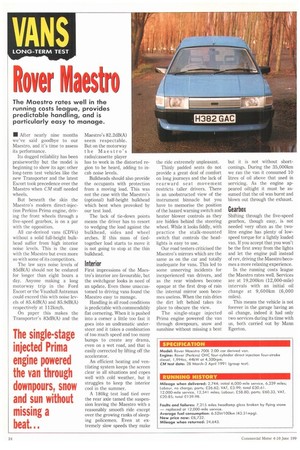Rover aestro
Page 26

If you've noticed an error in this article please click here to report it so we can fix it.
The Maestro rates well in the running costs league, provides predictable handling, and is particularly easy to manage.
/ After nearly nine months we've said goodbye to our Maestro, and it's time to assess its performance.
Its dogged reliability has been praiseworthy but the model is beginning to show its age: other long-term test vehicles like the new Transporter and the latest Escort took precedence over the Maestro when CM staff needed wheels.
But beneath the skin the Maestro's modern direct-injection Perkins Prima engine, driving the front wheels through a five-speed gearbox, is on a par with the opposition.
All car-derived vans (CDVs) without a solid full-height bulkhead suffer from high interior noise levels. This is the case with the Maestro but even more so with some of its competitors.
The law says noise levels of 85dB(A) should not be endured for longer than eight hours a day. Anyone making a long motorway trip in the Ford Escort or the Vauxhall Astramax could exceed this with noise levels of 85.4dB(A) and 85.9dB(A) respectively at 112km/h.
On paper this makes the Transporter's 83dB(A) and the Maestro's 82.2dB(A) seem respectable. But on the motorway the Maestro's radio/cassette player has to work in the distorted region to be heard, adding to incab noise levels.
Bulkheads should also provide the occupants with protection from a moving load. This was not the case with the Maestro's (optional) half-height bulkhead which bent when provoked by our test load.
The lack of tie-down points means the driver has to resort to wedging the load against the bulkhead, sides and wheel arches. If this mass of tiedtogether load starts to move it is not going to stop at the thin bulkhead.
Interior
First impressions of the Maestro's interior are favourable, but the switchgear looks in need of an update. Even those unaccustomed to driving vans found the Maestro easy to manage.
Handling in all road conditions is predictable with commendably flat cornering. When it is pushed into a corner a little too fast it goes into an undramatic understeer and it takes a combination of too much speed and too many bumps to create any drama, even on a wet road, and that is easily corrected by lifting off the accelerator.
An efficient heating and ventilating system keeps the screen clear in all situations and copes well with cold weather, but it struggles to keep the interior cool in the summer.
A 180kg test load tied over the rear axle tamed the suspension leaving the Maestro with a reasonably smooth ride except over the growing ranks of sleeping policemen. Even at extremely slow speeds they make the ride extremely unpleasant.
Thinly padded seats do not provide a great deal of comfort on long journeys and the lack of rearward seat movement restricts taller drivers. There is an unobstructed view of the instrument binnacle but you have to memorise the position of the hazard warning switch and heater blower controls as they are hidden behind the steering wheel. While it looks fiddly, with practice the stalk-mounted switch that controls the headlights is easy to use.
Our road testers criticised the Maestro's mirrors which are the same as on the car and totally inadequate for vans. This led to some unnerving incidents for inexperienced van drivers, and as the rear windows become opaque at the first drop of rain the internal mirror soon becomes useless. When the rain dries the dirt left behind takes its place to obscure the view.
The single-stage injected Prima engine powered the van through downpours, snow and sunshine without missing a beat but it is not without shortcomings. During the 35,000km we ran the van it consumed 10 litres of oil above that used in servicing. As the engine appeared oiltight it must he assumed that the oil was burnt and blown out through the exhaust.
Gearbox
Shifting through the five-speed gearbox, though easy, is not needed very often as the twolitre engine has plenty of lowspeed torque for a lightly loaded van. If you accept that you won't be the first away from the lights and let the engine pull instead of rev, driving the Maestro becomes a more relaxing experience.
In the running costs league the Maestro rates well. Services are at 19,200km (12,000-mile) intervals with an initial oil change at 9,600km (6,000 miles).
This means the vehicle is not forever in the garage having an oil change, indeed it had only two services during its time with us, both carried out by Mann Egerton.














































































































